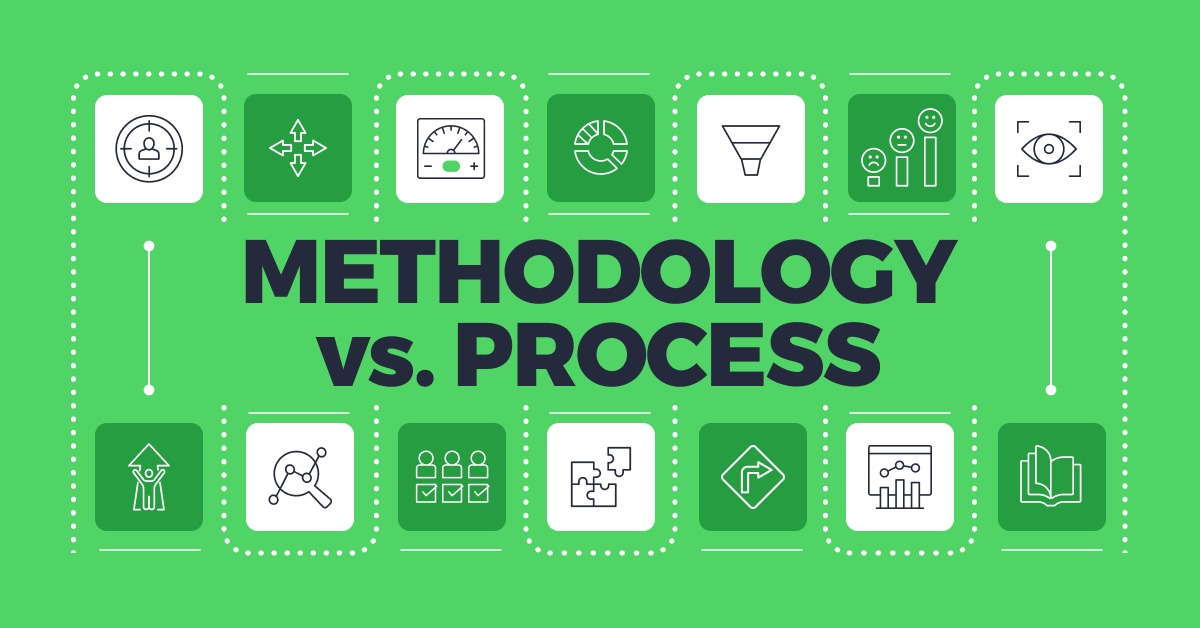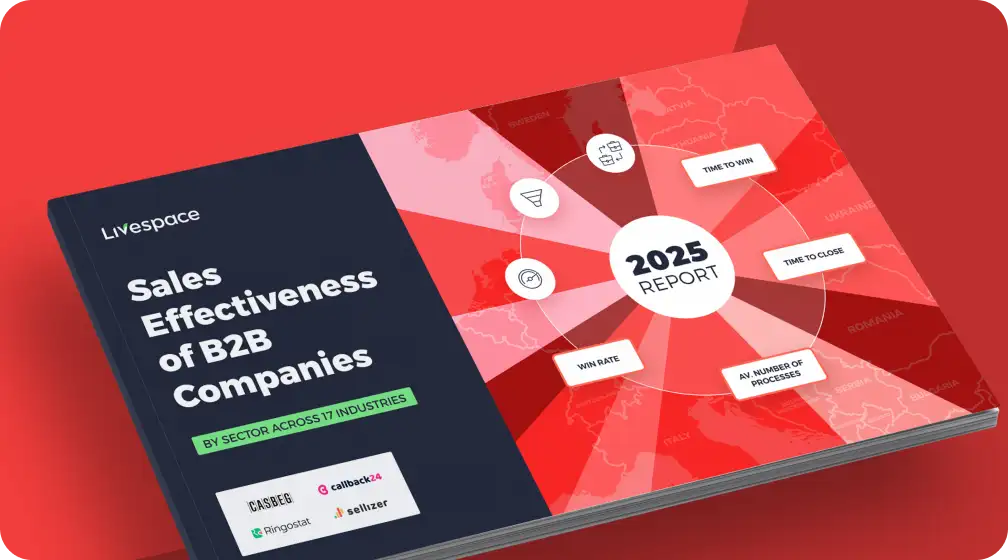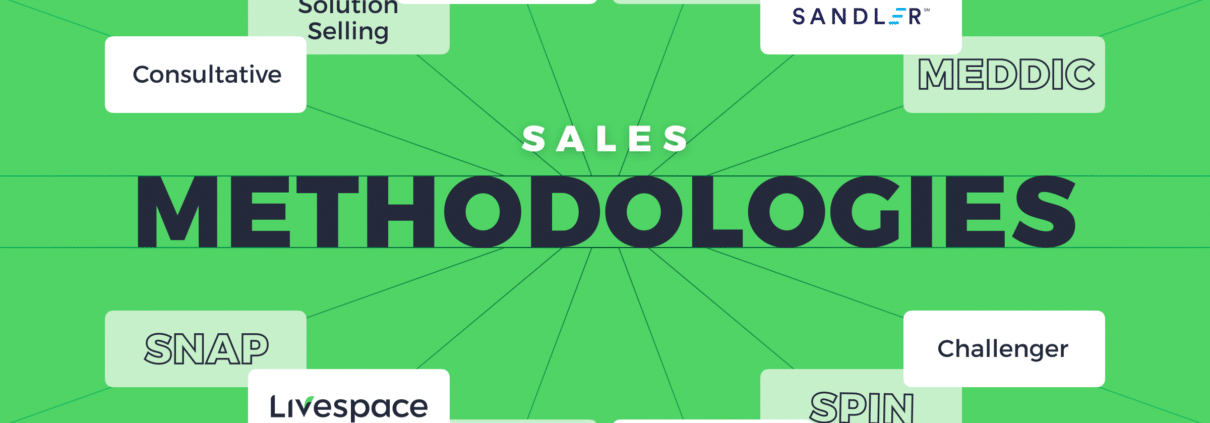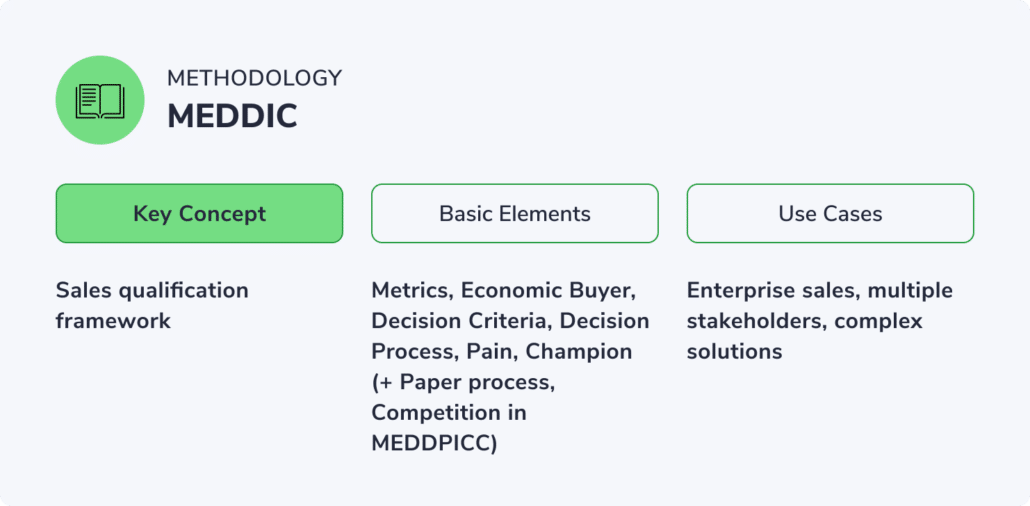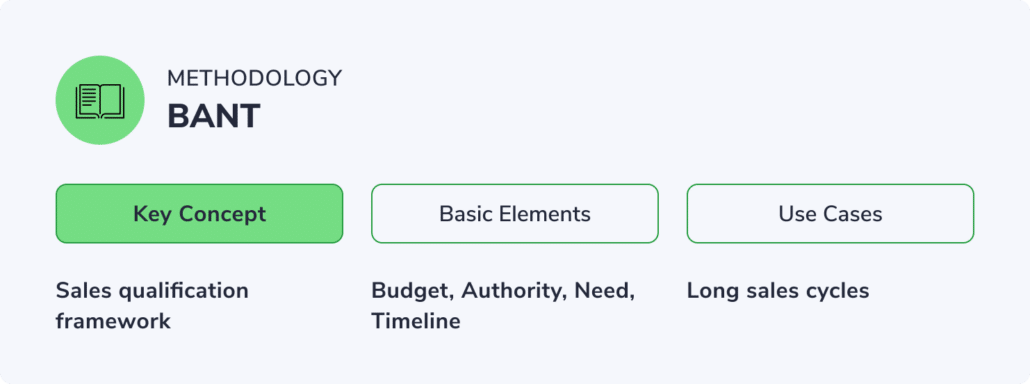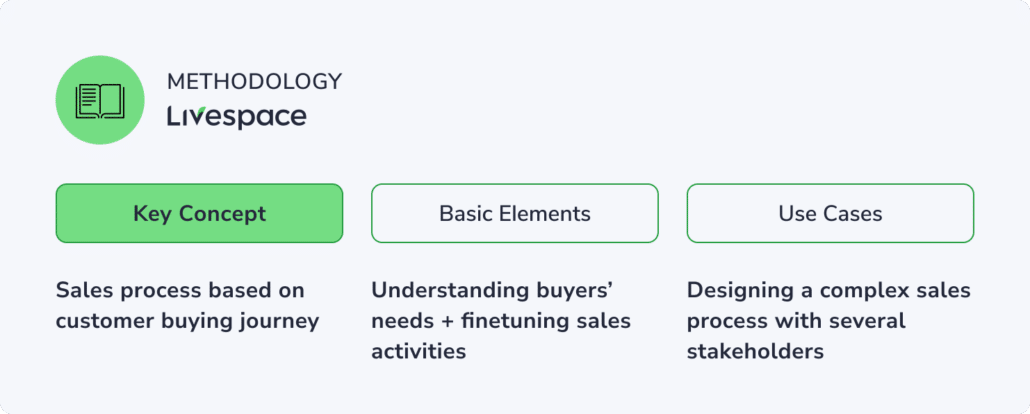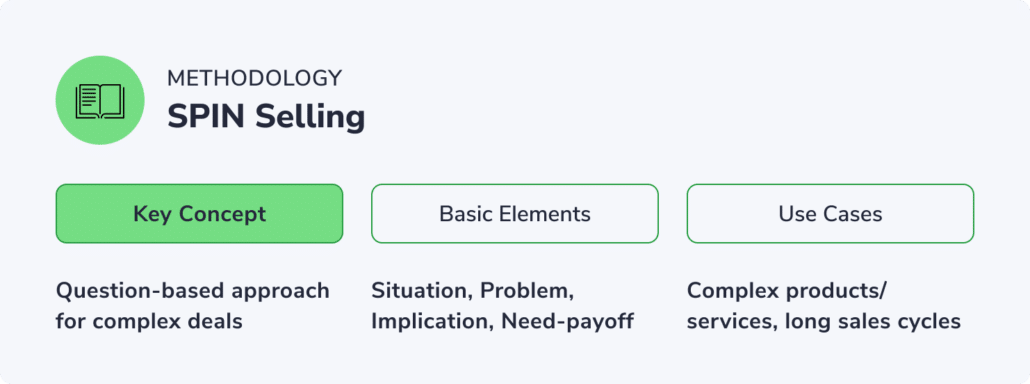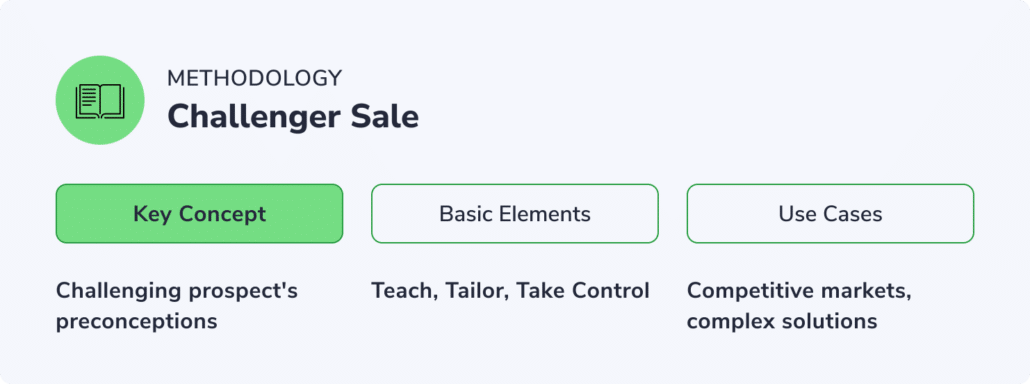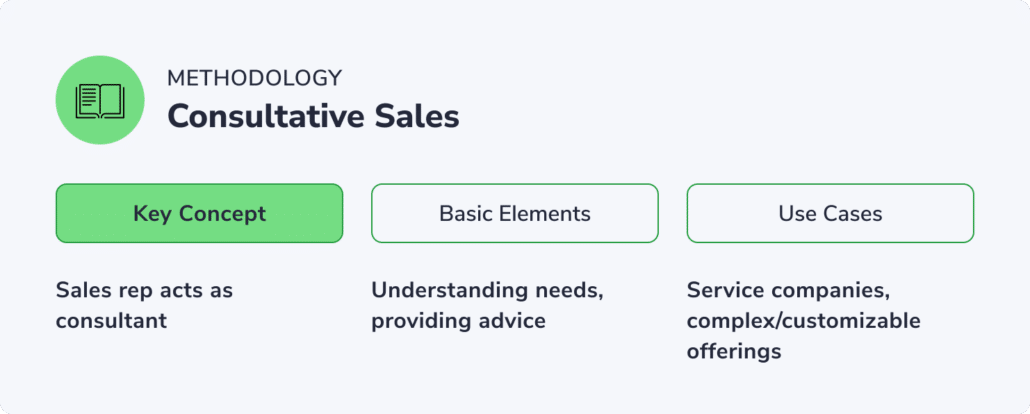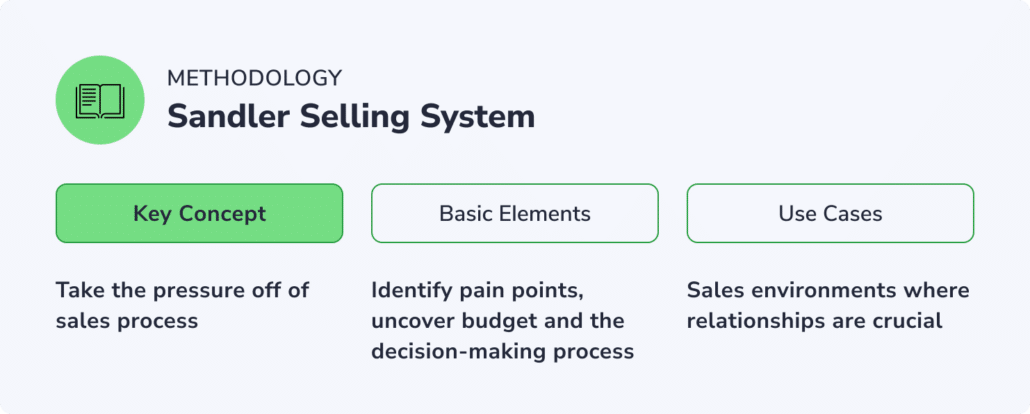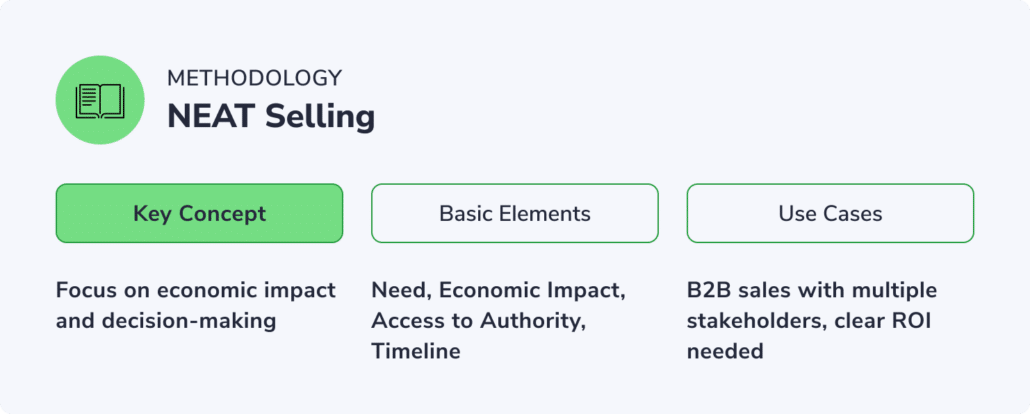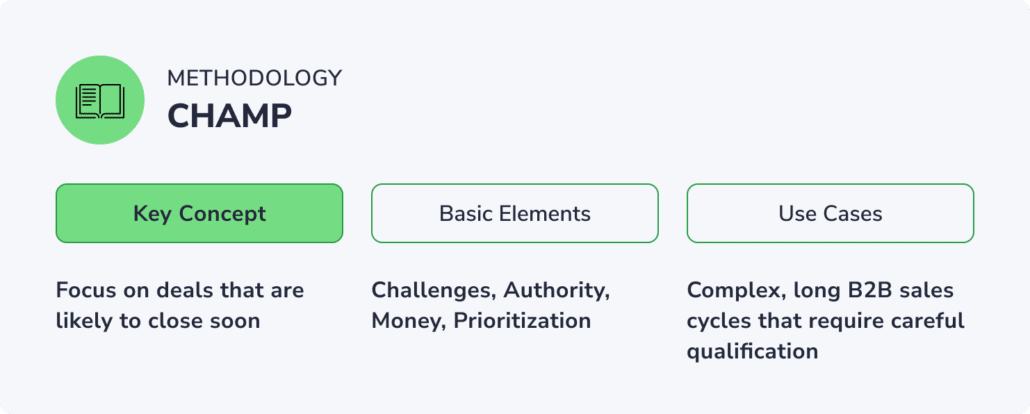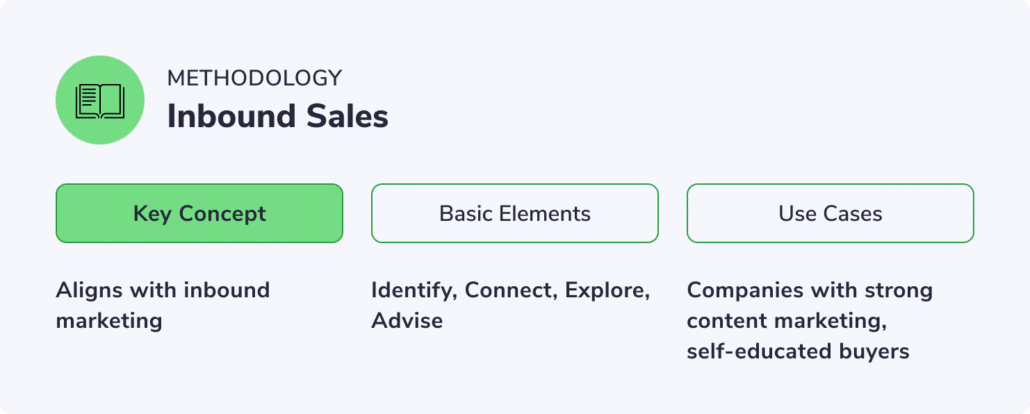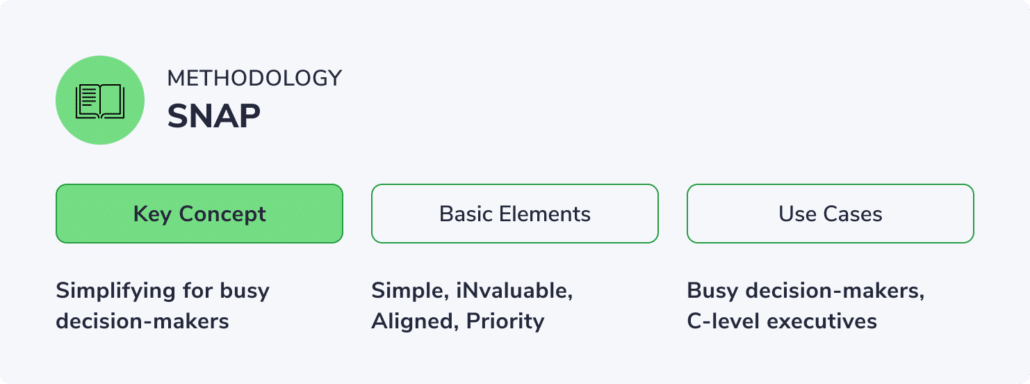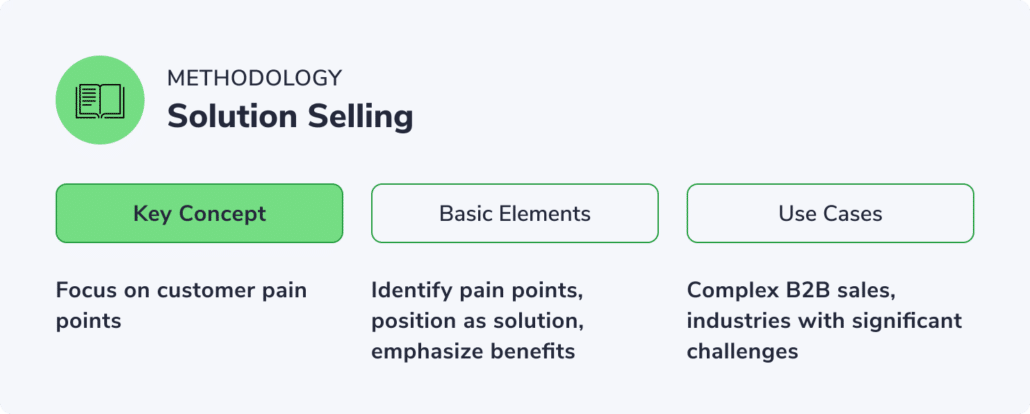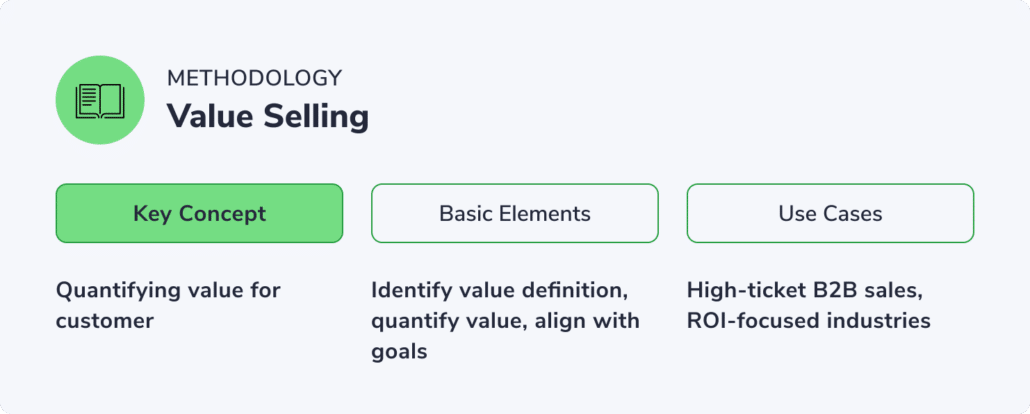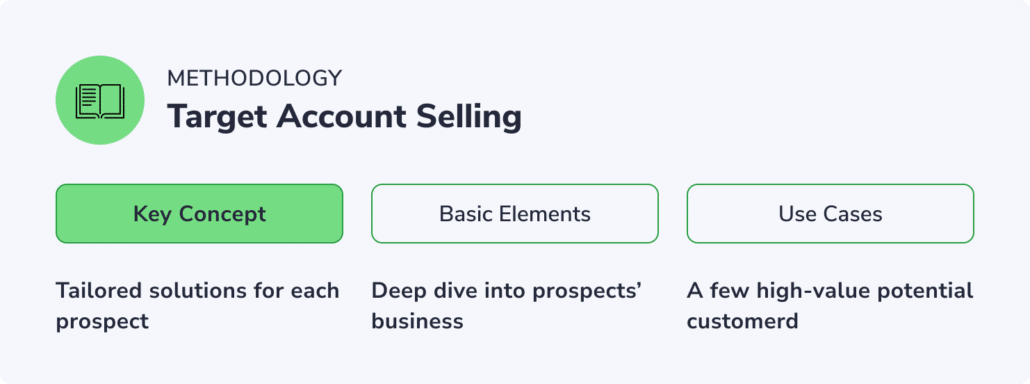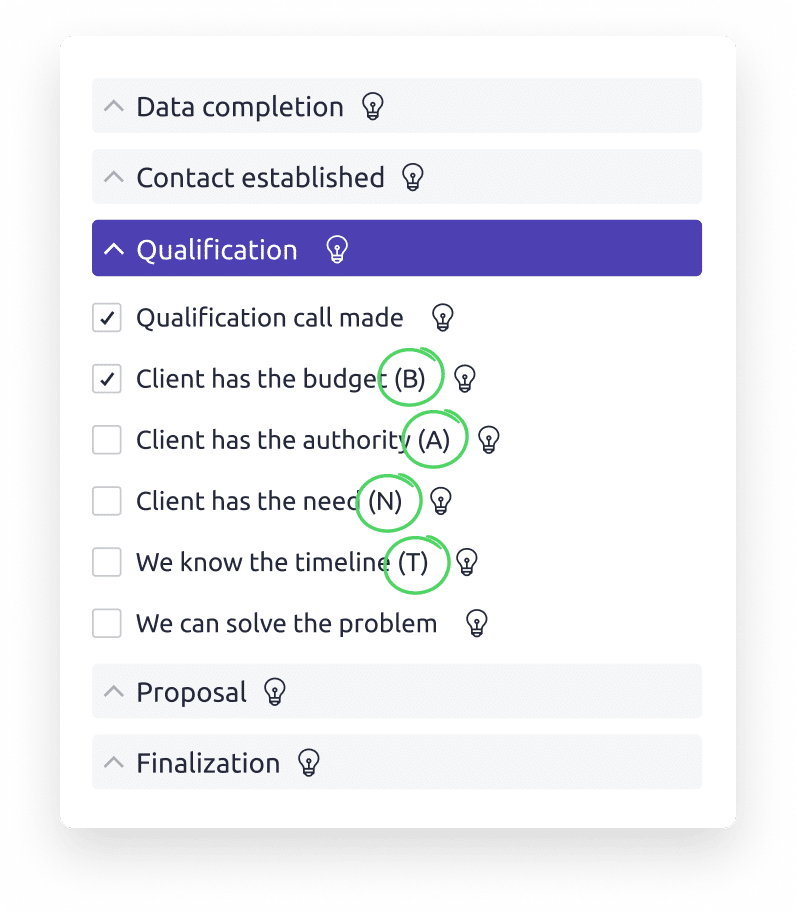Sales Methodology Overview
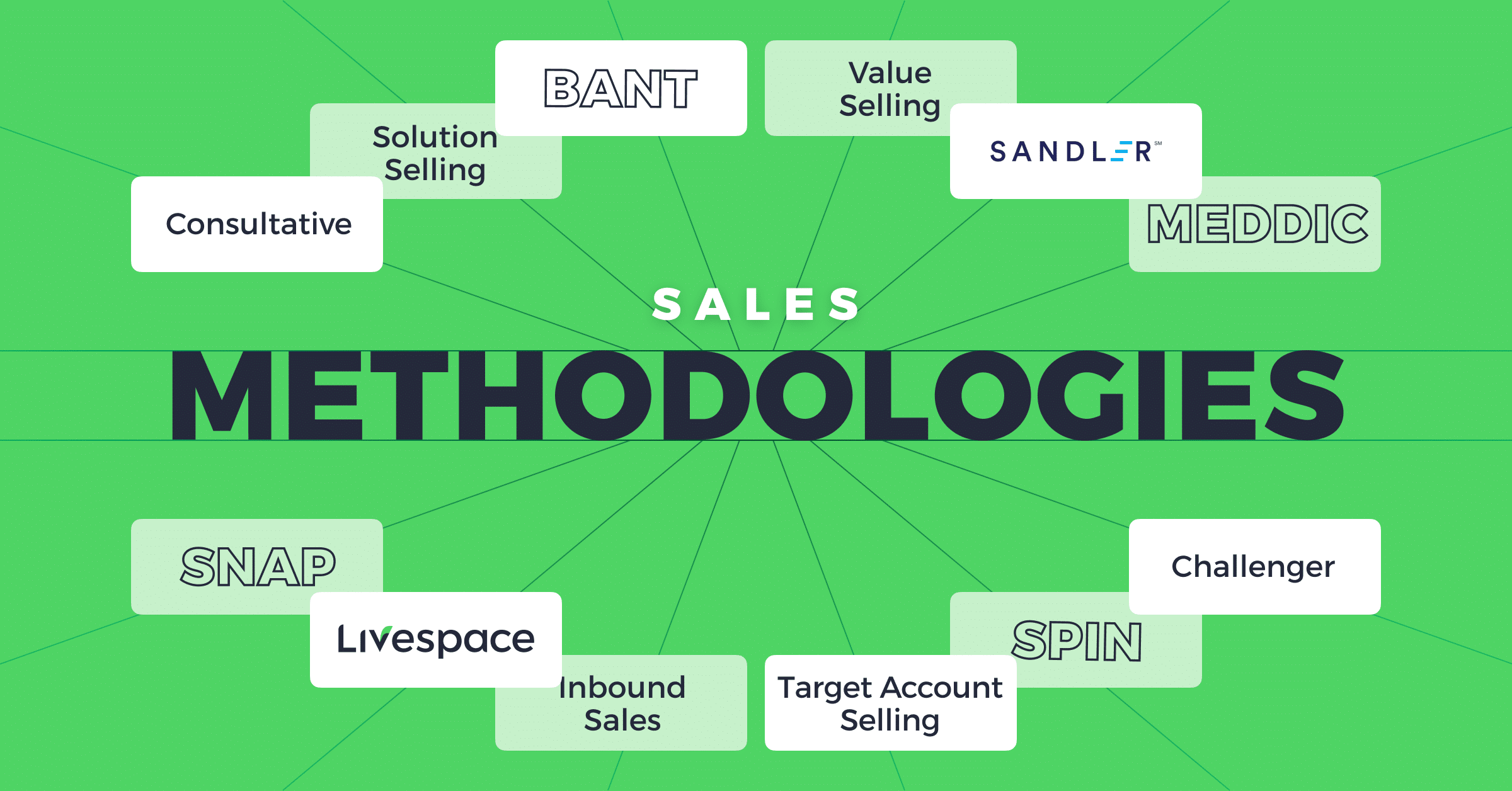
Looking for tried and tested approaches to selling? We’ve got you covered with our sales methodology overview.
We wanted to check which one is the most popular within our community.
But, after a quick survey, it looks like there’s no clear leader:

Keep reading to learn more about each of them (and 10 more) and choose your option!
TLDR: basic info on sales methodologies
- They are frameworks for selling approaches
(check What is a sales methodology?) - They give you more control over your sales
(check Why should you use a sales methodology?) - They’re really diverse
(check How to choose a sales methodology?) - And you need to plan out the implementation process
(check How to implement a sales methodology?)
We dive deeply into 7 sales methodologies:
- MEDDIC Sales Methodology
- BANT Sales Methodology
- Livespace Sales Process Design Methodology
- SPIN Selling
- The Challenger Sale
- Consultative Sales
- Sandler Selling System
You’ll find there:
- Detailed framework description
- Who would benefit from each one
- What are the strengths and weaknesses
- And some tips for implementation
Additionally, you’ll get a quick overview of other 7 sales methodologies:
- NEAT Selling
- CHAMP Sales Methodology
- Inbound Selling
- SNAP Selling
- Solution Selling
- Value Selling
- Target Account Selling
What is a sales methodology?
Often they don’t cover the entire process, focusing on a specific area, like lead qualification (MEDDPICC, BANT), or tackle the overall sales approach (The Challenger Sale or Consultative Sales).
Sales methodology vs sales process
Sales methodologies and sales processes are closely related – yet they don’t mean the same thing. The basic difference:
- sales methodology is a theory
- sales process is the theory applied in real life
Let’s be more specific, though.
Sales methodologies are more generic, high-level thinking. They help you structure the specific stage of the sales process. Also, they make a great sanity check: does my selling work as it should?
Sales processes, in change, are more specific: think about them as your game plan. They represent literally what sales methods you use to close the deal. You could (and should!) have a few in place for different client types (by deal size or industry).
To learn more about this topic, check our sales process guide for managers!
As sales processes represent your actions, they can differentiate the top performers from the bottom performers – and that’s key for improving your sales team. Sales methodology can’t tell you that.
What is a sales model?
There’s a third notion that can be confused with sales methodology and sales process: the sales model.
It describes the overall way you sell and where you allocate your resources. For example, you probably have a mix of inbound and outbound selling. The exact proportions make up your sales model.
To compare the terminology:
- sales model impacts how you structure your team
- sales methodologies define your approaches to certain stages of the sales process
- sales process(es) list the exact steps you take to close the deal
Sales model elements examples are: inbound, outbound, account-based selling, or self-service.
Why should you use a sales methodology?
By implementing a sales methodology, you basically get a framework to work on. It improves several important aspects of your sales performance.
Consistency gives you predictable sales
First of all, it helps you develop a consistent sales process. This standardized approach means:
- predictable results and forecasting
- improved sales quality and performance
- increased control over sales reps’ actions
Also, as sales methodologies have been tried and tested in multiple environments, you implement proven sales techniques. It helps you ask the prospect better questions or become a trusted partner.
You get more control over sales reps work
Framework consistency translates into common rules for team work. Thanks to that, you get:
- a systematic, repeatable approach to understanding the customer’s business
- better handoffs in team (for example, between the qualification team and sales reps)
- a common flow for discussing the deals
All of those points impact your sales analysis: you gather consistent, comparable data. And it means it’s easier to spot areas for improvement in your sales.
Pro tip: Use your CRM to facilitate following the methodology. Custom fields, automated tasks and follow-ups will help you gather good data!
The last, but not least element is scalability. When you adjust the sales methodologies to your needs, you get a blueprint of what works in your organization. It’s crucial when you prepare for scaling, as:
- you know where to pour the additional resources
- you can forecast what to expect
- and it’s much easier to onboard new people.
Paweł Paluch, Head of Sales, Livespace
When you go into scaling without a proven sales process and data, you risk drowning in activities that don’t bring expected results. Your reps would spend weeks on irrelevant deals. The result? They no longer deliver the targets, and your financial results dive deep. To scale your sales, you need to know what is important: and having a sales methodology in place gives you data on that.
How to choose a sales methodology?
TLDR: the right sales methodology is the one you’ll actually use.
Evaluate your current sales efforts and goals
To choose an appropriate methodology, you need to understand where you are – and where you want to be. For that, you need to know:
- what’s your existing sales process (even if it’s not formalized)
- company specifics: targets, sales model, team size and tools
- and your success patterns: what do won deals have in common?
Describe those factors: they’ll lay the ground for your decision process and criteria. To get a thorough image, include insights from other colleagues involved in the process.
Compare different sales methodologies
When you have your situation clear, it’s time to choose the first sales methodology to try out. Talk to other sales leaders when doing the research: workshops or peer opinions can give you valuable insights.
Resources make another important issue. The more complicated methodology, the more training it requires to work properly for your team. As a sales leader, you need to balance the investment in future deals with on-going demands so that training doesn’t disrupt your sales team performance.
Finally, organize a pilot test, implementing chosen methodologies on a small scale. Set up performance metrics and gather feedback from your sales reps.
How many sales methodologies can you follow?
There are no strict guidelines. Take a look at the pros and cons of each approach:
One sales methodology:
- pros: the easiest implementation process, easy to onboard new sales team members
- cons: might not cover every case
2-3 sales methodologies:
- pros: more flexibility, cover almost all cases
- cons: increased implementation difficulty
4+ sales methodologies:
- pros: high customization to your needs
- cons: might be difficult to manage and onboard new sales reps
Our take: Start with implementing one sales methodology. With time, you’ll be able to expand and tweak them to your needs.
MEDDIC Sales Methodology
What is the MEDDIC Sales Methodology?
As it addresses the crucial sales cycle stage, it lets you see whether the deal you work on has any chance to succeed and gives you intel to understand the customer’s buying process.
Created in the mid-90’s, MEDDIC evolved to MEDDPICC, covering more complex selling scenarios. That’s why it helps create a common language for naming factors of an opportunity for all people interested in a company’s revenue.
M – Metrics
It’s the way you measure the provided value. In each case it might be different: you can compare the value with their current solution or a competing one.
E – Economic Buyer
The economic buyer is the person with overall authority in the buyer organization (often it’s the person who holds the money).
D – Decision Criteria
Decision criteria tell you what is important for the buyer. It helps you attach value to their criteria.
D – Decision Process
You also need to know how they take purchasing decisions, and what’s involved in their decision making process.
P – Paper process
Here you cover all the paperwork process, potential obstacles and timeline for closing the deal. It’s one of the added elements.
I – Implicate Pain
This step is about finding out what pain can you solve, how serious it is, and – also – active work on making it look more worrisome.
C – Champion
Champion is the person who supports us internally within the organization and shares important information (a former user or fan). It’s the key factor to win the deal.
C – Competition
Find out about other factors competing for the same resources (money, attention etc). Think about them as other ways for the buyer to solve their problem. It’s the other added element.
Who should use the MEDDIC sales methodology?
MEDDPICC works best for enterprise sales organizations who deal with multiple stakeholders and offer complex individual solutions.
Strengths and weaknesses
- Good for enterprise deals that takes a lot of time
- Precise
- Focuses on ROI and business outcomes for the client
- Not good for small deals
- Takes a long time to implement
- In-depth knowledge of prospect’s business
Tips for implementation
- Work on culture and discipline so that it becomes a common thing for all revenue-connected people
- Integrate fields into the CRM to keep the data in order
BANT Sales Methodology
What is the BANT Sales methodology?
It covers the 4 basic indicators which show that your customer is ready to buy from you:
B – Budget: Do they have the budget?
A – Authority: Who has the sign-off?
N – Need: What’s the need/pain? How critical is it?
T – Timeline: When do they need the solution?
If your prospects can’t answer those questions clearly, they probably aren’t serious about the purchase.
As you can see, it’s nothing ground-breaking – yet a lots of companies get stuck with deals that don’t show those qualities.
Who should use the BANT Sales methodology?
If you look for simplicity or the first sales methodology to implement, BANT (or similar methodology) might be a good call. It helps you gather the basic info you need for qualification.
Strengths and weaknesses
- Simpler (four criteria only)
- Quick qualifying process
- Others are more comprehensive
- Less relevant nowadays: there are more flexible alternatives
- Not client-oriented
Tips for implementation
- Good for initial qualification
- Don’t use literally 4 questions: it can’t be an interrogation
Livespace Sales Process Design Methodology
What is the Livespace methodology?
This methodology focuses on how to set up your sales process so that your sales organization gets predictable results. It works with any methodology and any CRM, and makes a perfect tool for sales managers to boost the sales performance.
Let’s take a look at the flow:
- Company profile
You start with describing your company with basic sales info: like customer acquisition sources, products and target groups. - Initial customer segmentation
On this stage, you choose the segment for which you’ll create the sales process. The key factor is how you sell! - Listing sales activities
Now, it’s time to list all the activities you do in the process. Our hint: check if they make sense when looking backwards. For example, you can’t send a proposal you haven’t made. - Customer buying process
Let’s switch focus to the core element of the Livespace methodology: the customer buying process. Gather everything you know about your buyer’s activities. - Key personas identification
Now, add key personas responsible for those activities, like Sales Director or CFO. - Key personas in buying process
And create their profiles by responding to our questions. This helps state the role and tasks in the buying process. - Completing the buying process
Now, go back to the buying process with new info: something comes up everytime! - Sales activities supporting the buying process
Think about everything your team (and probably marketing) can do to help the customer move forward. - Combining the buying process with the sales process
Now it’s time to join the ideas from the buying process and sales process. Look for new things you could implement in your sales process. - Naming the sales process stages
Finally, it’s time to group those steps in stages and name them. - Customer state change analysis
The last part is where you point out changes in two areas: what you learn about the customer, and what the customer learns about you.
The best part? You can handle the entire creation in one day: from zero to fully operational sales process.
We get into more details in our sales process guide – make sure to check it out!
Who should use the Livespace methodology?
Try Livespace methodology when the traditional sales process creation (aka let’s just follow a generic sales process) hasn’t worked for you. That’s especially true for long and complex sales processes: they need to be fine-tuned to your sales organization.
By following our know-how, you’ll:
- make sure all the actions are listed: that’s especially tricky when the process is complex and involves multiple decision makers
- determine what brings the sales success and expand on those activities
- lay the foundation for consistent, predictable sales results.
In short, sales process design discovers the formula that brings results for your company.
It’s not magic, it’s maths – and you can get full control of the process.
This said, it’ll be an overkill for simple, transactional sales. If that’s your successful sales model, you’d better pour your efforts in other areas.
Strengths and weaknesses
- it’s universal: no matter how big or small your sales team is, you’ll find value here
- you don’t need extensive sales training to use it: our free webinar will be enough
- convincing all stakeholders that they should take part in the design process can be tricky: but it brings so many insights!
- it’s not a one-off effort: you need to revisit the process on a regular basis
Tips for implementation
- tackle one sales process at a time
- use a CRM system to track sales reps’ activities and results
- revisit your sales process when the buyer’s journey changes
SPIN Selling
What is the SPIN Selling methodology?
Its goal is to create the perception of value in the client’s head by having them reply to thought-through questions.
SPIN Selling was coined in the late 80’s by Neil Rackham and team. After years researching what differentiates the sales top performers, they came up with a key insight:
Top performers know what to ask, and in what order: they don’t use low-value questions.
So, taking questions as the basic element, they grouped them in four categories by their goal:
- Situation: Understand the prospect’s current state
- Problem: Identify specific issues
- Implication: Explore consequences of the problem (as many as possible)
- Need-payoff: Demonstrate the value of solving the problem
Keep in mind the “question value” point. In the Situation category you should use as few questions as possible: asking only for things that you can’t learn in other sources than the client (research is key!). That’s not the case of Problem and Implication questions: they open up in-depth discussions.
The last category, Need-payoff questions, makes your client talk about the benefits of your product or service: instead of having them listen to you. Some questions that get into this category are:
- How would you benefit from speeding this process up by 30%?
- What are the main benefits from limiting the meetings in your team?
- What would change if you had all the sales process steps directly in your CRM?
They help you uncover the real needs that you prospect can solve with your product or service – and, most importantly, reduce the number of objections. After all, it’s the prospect who comes up with all the advantages!
Who should use the SPIN Selling methodology?
As this sales methodology helps you go deep into your prospect’s problems, it works best for complex products or services and long sales cycles.
For transactional, simpler sales processes it’s an overkill.
Strengths and weaknesses
- fits in with other sales methodologies
- perfect for inbound sales
- boosts active listening and asking the right questions skills
- easy to come across as scripted
- lots of training
Tips for implementation
- avoid questions for which you can google the answer
- use role play for training
- focus on questioning and listening skills
The Challenger Sale methodology
What is the Challenger Sale Methodology?
In 2011, Matthew Dixon and Brent Adamson published a book where they stood against the most common approach in B2B sales: the relationships building priority. From their perspective, the top performers teach, tailor their approach, and take control of a sales experience: they are the Challengers.
And the authors have data to back it up. Based on their extensive research, they identified and described 5 profiles of sales reps:
- The Hard Worker: goes the extra mile and is self-motivated
- The Relationship Builder: generates customer loyalty and invests time in building connections with clients
- The Lone Wolf: works on their own
- The Problem Solver: ensures all the customer’s problems get solved
- and The Challenger: loves discussing with customers and showing them different perspectives they haven’t thought about.
For example: when you uncover a new problem your customer hasn’t thought about, you’re the challenger.
And that makes them stand out. With a buying process that involves several competitors, the sales rep who sheds new light on customer’s pain points can win the deal.
Who should use Challenger sales methodology?
In today’s competitive markets… scratch that. The Challenger Sale helps you stand out from your competition and point to the unique strengths of your product or service. By being in control of the conversation, you can push the process forward in situations when other approaches stagnate.
Complex solutions give you space for challenging prospect’s preconceptions and teach them new points of view. It requires understanding the customer’s pain points and business and creating constructive tension.
Beware, though: not all sales reps will notice results. The Challenger approach brings effects with top performers: the average sales rep hasn’t proved to be more effective compared to other profiles.
Strengths and weaknesses
- Differentiates salespeople
- Reps add value beyond the product
- Requires high business understanding by the reps
- Can come across as confrontational
Tips for implementation
- Invest in continuous learning for sales reps
- Develop a library of insights and challenging ideas
- Fine-tune your qualification process to notice if this approach is a good fit
- Encourage collaboration between sales and marketing to create valuable content
Consultative Sales methodology
What is the Consultative Sales methodology?
It’s the approach chosen by many sales organizations and has developed into various popular sales methodologies. Sales reps focus on understanding the customer’s pain points and buying journey, and provide them with tailored solutions.
There’s a huge focus on defining customer needs and giving advice beyond the product info.
Who should use the Consultative Selling methodology?
Consultative selling helps service companies shine. After all, it’s about showcasing their assets when selling their services.
Similarly, it’s useful for complex or customizable offerings and industries where you need to build customer relationships.
Strengths and weaknesses
- Builds long-term relationships
- Sales rep works as an advisor
- Time-consuming
- Deep product and industry knowledge, hard to onboard
Tips for implementation
- focus on listening and problem solving skills
- use other clients’ examples to make your points stronger
Sandler Selling System
What is the Sandler Selling System?
Unlike other sales methodologies we discuss here, Sandler Selling System tackles the entire sales cycle. It aims to take the pressure off of sales professionals and prospects by opting for clarity and avoiding sales games. Both sides of the sales interaction are treated as equal partners (think: peer-to-peer, not seller-buyer).
It puts emphasis on the qualification stage – sales teams following Sandler guidelines:
- identify pain points
- uncover budget
- and understand the decision making process
All of that helps disqualify the prospects on time.
Who should use the Sandler sales methodology?
This sales methodology works best for complex sales environments: especially when long-term relationships make one of your sales strategies.
Also, if your sales team struggles with applying high-pressure techniques, this consultative selling approach might be more effective.
Strengths and weaknesses
- trust-based and customer-centric selling process
- reduces pressure during sales conversations
- huge time and training investment
- complexity
Tips for implementation
- there are wide training opportunities to teach your sales teams
- opt for role-playing trainings
- and set up your CRM properly so that the daily tools support your sales teams focus
Other sales methodologies you should know
NEAT Selling
NEAT Selling methodology focuses on economic impact, quantifying solution’s value and aligning it with prospect’s financial goals. That’s why it’s particularly effective when you need to clearly demonstrate the ROI.
Basic elements:
- Need: Identify and validate the prospect’s challenges
- Economic Impact: Quantify the cost of the problem and value of the solution
- Access to Authority: Ensure engagement with decision-makers
- Timeline: Establish a clear timeline for implementation
Use cases:
- B2B sales with multiple stakeholders
- Sales processes requiring clear ROI demonstration
CHAMP Sales Methodology
CHAMP sales methodology is a qualification framework that gives you deep intel into prospect’s business. It stands out by focusing on prioritization that helps you organize your sales pipeline and focus on deals that are most likely to close soon.
Basic elements:
- Challenges: Identify and understand the prospect’s business challenges and pain points
- Authority: Determine who has the decision-making power and influence in the buying process
- Money: Assess the prospect’s budget and the potential return on investment for your solution
- Prioritization: Understand where your solution fits in the prospect’s list of priorities and timelines
Use cases:
- Complex, long B2B sales cycles that require careful qualification
- Businesses selling solutions that require significant investment or organizational change
Inbound Selling
Inbound Selling methodology relies heavily on cooperation between marketing and sales teams, as it uses content to draw people into your sales funnel. Inbound selling is widely treated as an element of sales models, as it goes along most sales methodologies.
Basic elements:
- Identify: Attract and engage potential customers
- Connect: Initiate conversations with leads
- Explore: Discover the prospect’s goals and challenges
- Advise: Present a tailored solution
Use cases:
- Companies with strong content marketing strategies (Inbound Selling in fact was created in Hubspot)
- Businesses targeting self-educated buyers
SNAP Selling
SNAP selling aims to cut through the noise and reach your distracted prospects. With simplicity and focus on their needs, you can make your message stand out from the crowd. It covers the entire sales cycle.
Basic elements:
- Simple: Keep the sales process straightforward
- iNvaluable: Provide clear, significant value
- Aligned: Ensure your solution fits the customer’s needs
- Priority: Position your solution as a top priority
Use cases:
- Sales environments with busy, distracted decision-makers
- Companies selling to C-level executives
Solution Selling
Solution Selling positions the product or service as a solution to prospect’s pain points instead of focusing on product’s features. It works best for industries where customers face significant challenges.
Basic elements:
- Focus on the customer’s pain points
- Position your product or service as a solution to these problems
- Emphasize benefits over features
Use cases:
- Complex B2B sales
- Industries where customers face significant challenges
Value Selling
Value Selling focuses on quantifying the perception of value that each prospect has, which helps align the sales pitch with specific business goals. It’s useful for deals where you can win by demonstrating the ROI.
Basic elements:
- Identify the customer’s specific definition of value
- Quantify the value your solution provides
- Align your offering with the customer’s business goals
Use cases:
- High-ticket B2B sales
- Industries where ROI is a key decision factor
Target Account Selling
Target Account Selling is the right sales methodology when your sales team works with a few high-value opportunities. It dives deeply into given prospects, and makes your sales reps come up with tailored solutions that cover customer pain points.
Basic elements:
- Identify and focus on high-value accounts
- Develop deep understanding of these accounts
- Create tailored strategies for each target account
Use cases:
- Enterprise sales teams
- Companies with a small number of high-value potential customers
How to implement a sales methodology?
Until now, you’ve probably made a shortlist of best sales methodologies for your organization. Let’s talk about the implementation game plan!
3 steps to implement a sales methodology
- Secure buy-in from leadership and sales team
Any new sales methodology you want to implement affects several stakeholders: from (obviously) the sales team to the group you report to. Without their buy-in, you won’t be able to prove the value of even the most effective sales methodologies.Treat it as an offer presentation – you could even refer to the chosen framework, like SNAP Selling or Solution Selling. Make sure to:
- Present the benefits of the new methodology to key stakeholders
- Address concerns and potential resistance proactively
- Highlight how the methodology will benefit individual salespeople and the company
- Develop an implementation plan
As soon as you get the green light, you can plan out the implementation. Take into account time for training, setting up new tools, and evaluating the efforts.
- Set clear timelines for rollout phases
- Allocate necessary resources (time, budget, personnel)
- Assign roles and responsibilities for the implementation process
- Integrate the methodology into your CRM and sales tools
Take care of your work environment so that it supports working with a new framework.
- Customize CRM fields and processes to align with the new methodology
- Ensure all sales collateral and resources reflect the new approach
- Set up automated reminders and prompts to reinforce the methodology
Training and onboarding best practices
Each case will be slightly different: knowing your team lets you create your own best sales methodology training plan. Here goes our list of training best practices:
- mix theory with practice, focus on relevant, real-world examples
- use role-playing exercises to internalize new sales methodology
- provide shadowing opportunities with experienced sales professionals
- plan regular refresher sessions and offer additional resources
- set up a communication channel for methodology-related questions and support
- remember: regular hands-on practice is key!
Pro tip: Use your CRM to support you in following through. In Livespace, you can set up exact steps to follow, and enrich them with video and text tips.
Measuring success and setting KPIs
The right metrics are key for measuring your success in using a sales methodology. How to approach this area?
- Start with baseline metrics
Note the results you had before implementing a sales methodology: you’ll be able to compare its effect. - Define KPIs aligned with specific methodology
Use conversion rates, win rates, average deal size or sales cycle length to measure the effectiveness. - Use your CRM for data tracking and analysis
Set up your CRM so that it’s easy to gather methodology-specific data (like MEDDPICC scores). - Set up regular performance reviews
Schedule regular meetings and use data to identify patterns in sales performance. - Gather qualitative feedback
Look for feedback both in your sales team and customer group. Those insights will be invaluable for refinement and further training.
Whatever sales methodology you use, a Customer Relationship Management system (CRM) is a must. If you want to find out more, check out our guide to CRM.
Refinement phase
What should you consider when planning refinements?
- Review the results on a regular basis
- Identify top performers and analyze their approach for best practices
- Adjust the methodology when market conditions change
- Act on feedback from the sales team
- Regularly report on the impact of refinements to key stakeholders
What’s your take on sales methodologies?
We hope this sales methodology overview proved useful, and now you’ve got a shortlist of frameworks to check out.
If you want to see how Livespace CRM supports each sales methodology, get in touch with us!
Other posts
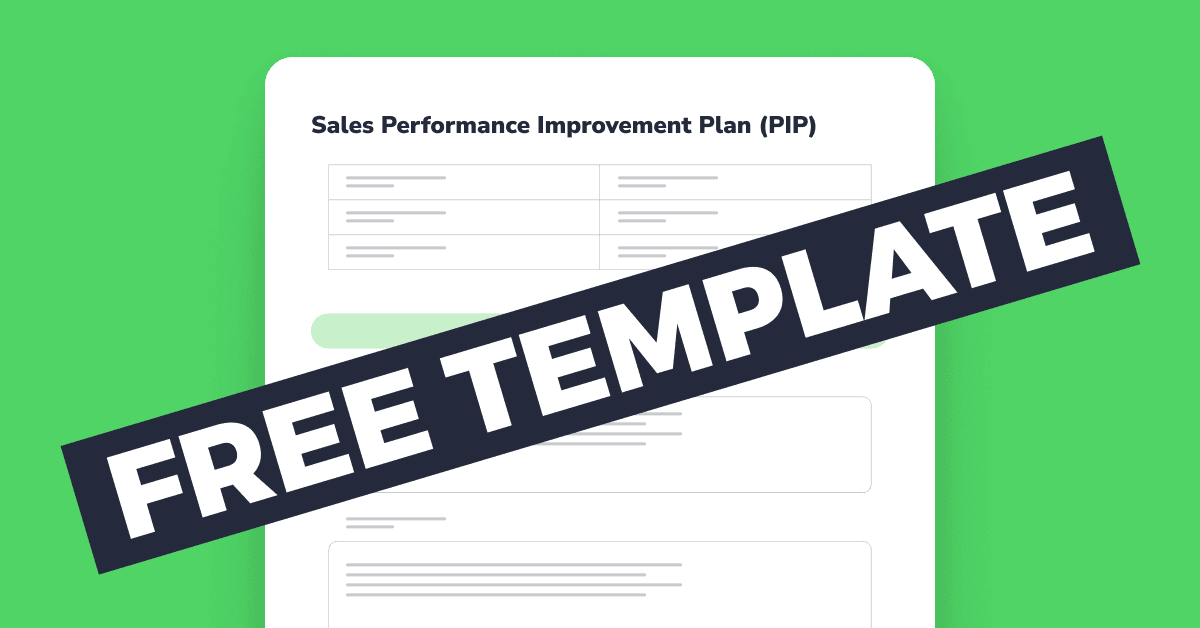
What is a Sales Process Flowchart? Sales Process Flowchart explained (with Examples)
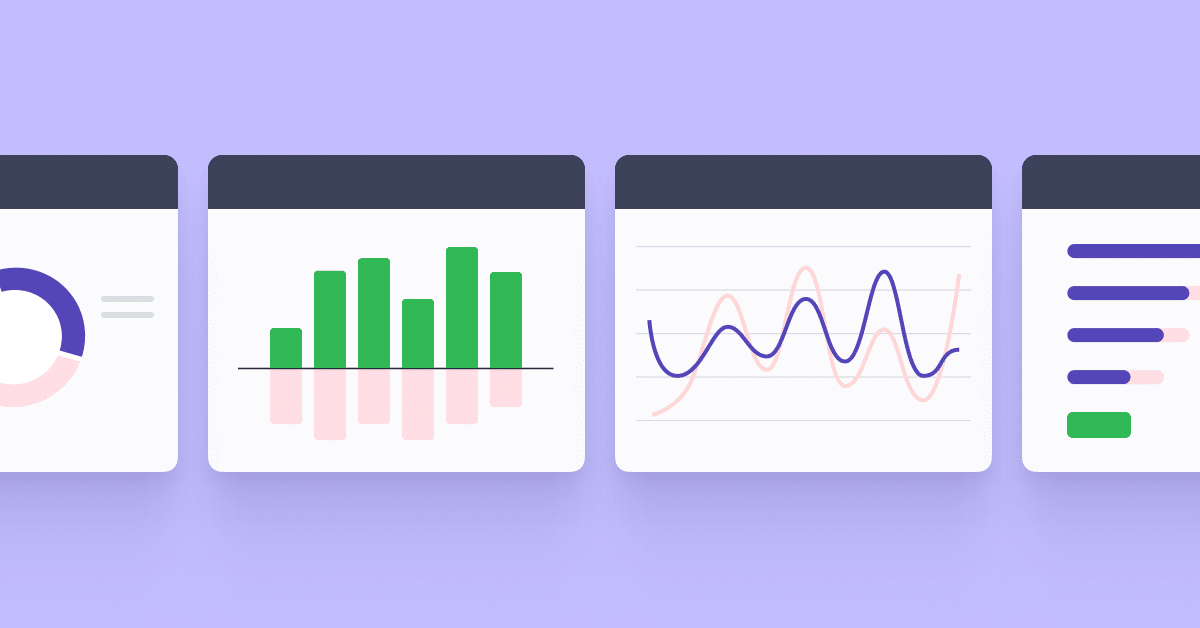
7 most widely used sales reports (with free downloadable templates)
